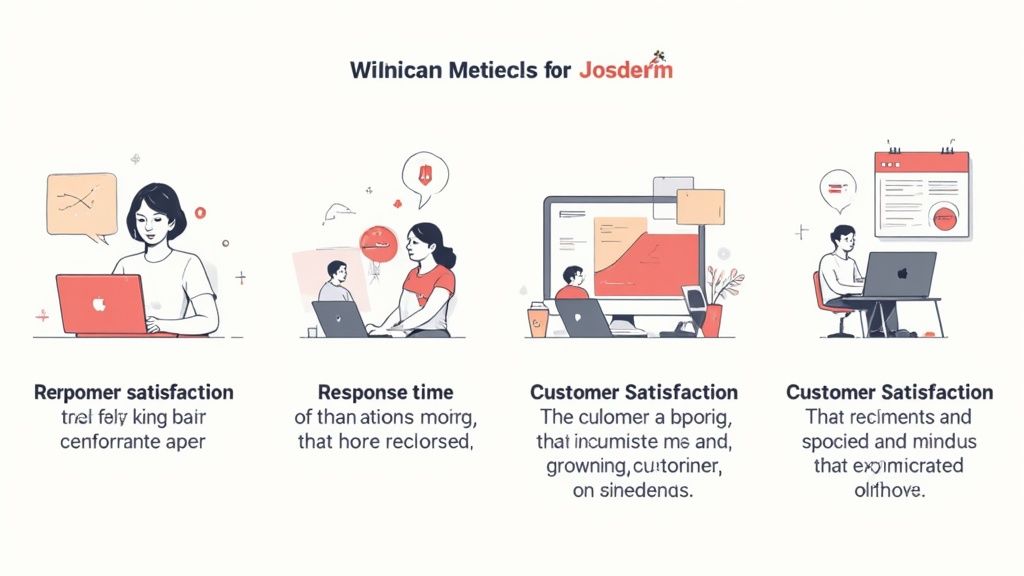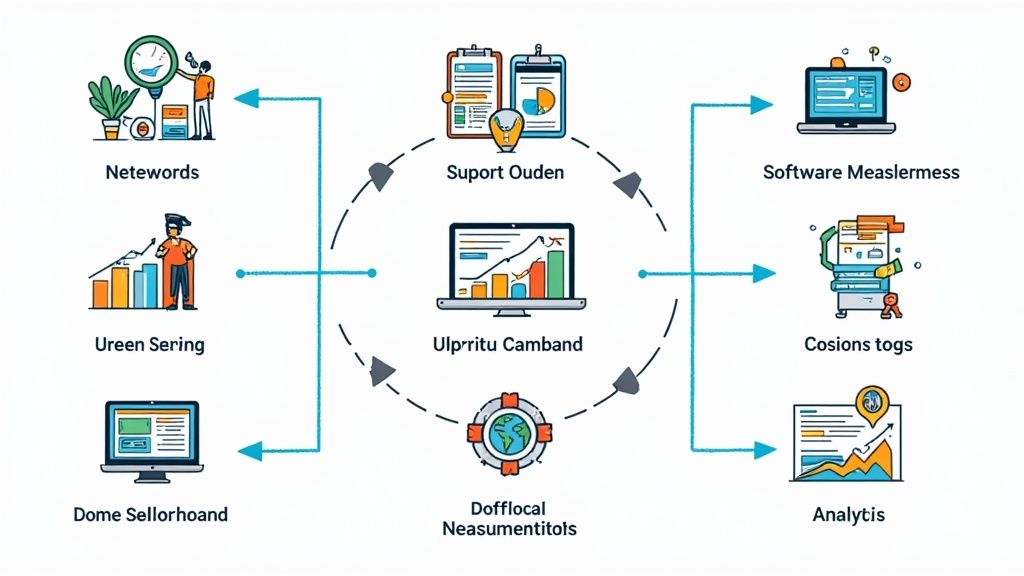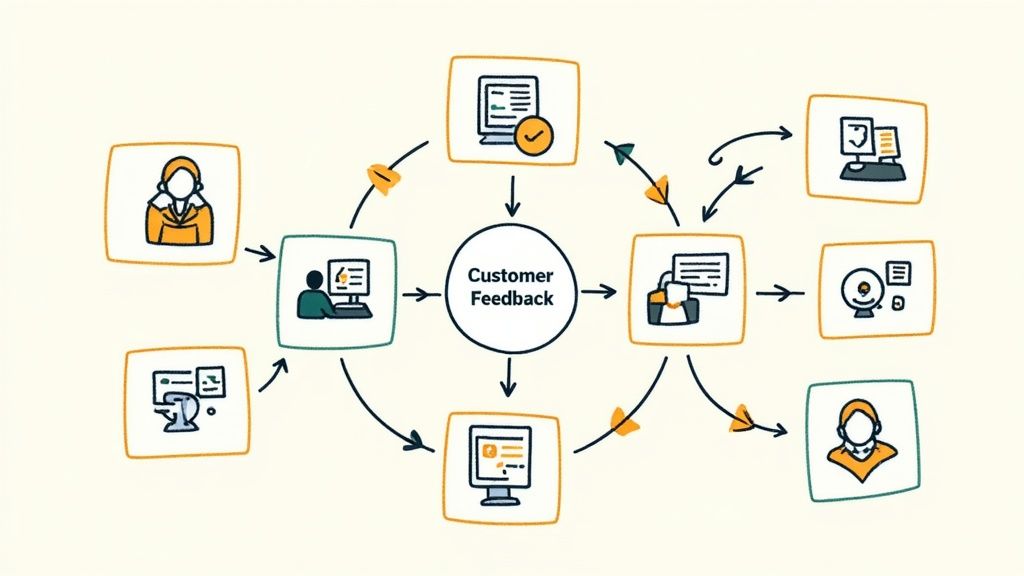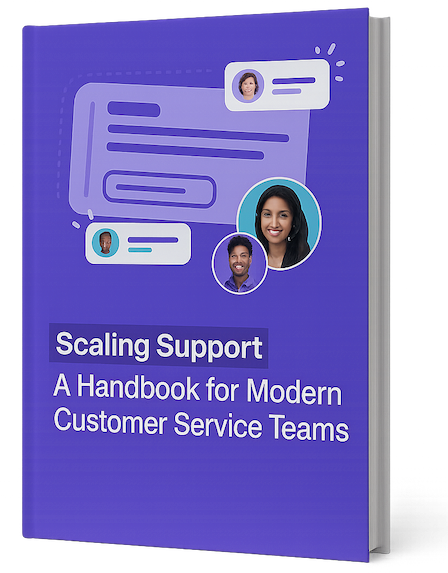The way businesses measure customer service has changed dramatically. Gone are the days when tracking call volume alone was enough. Modern companies need to examine every touchpoint along the customer journey and understand how these interactions shape the overall experience. Research shows that exceptional customer service can increase revenue by 4-8% above market rates.
Key Metrics for Modern Customer Service
Smart measurement focuses on metrics that directly impact business outcomes. While basic metrics like handle time still matter, the most successful companies track a broader set of indicators that paint a complete picture of performance:
- Customer Satisfaction (CSAT): This score tells you how happy customers are with specific interactions. Regular CSAT monitoring helps pinpoint exactly where service shines or needs work.
- Customer Effort Score (CES): This measures how easy it was for customers to get help. Lower scores mean smoother experiences, while higher numbers flag friction points to address.
- Net Promoter Score (NPS): By asking customers how likely they are to recommend your business, NPS reveals loyalty levels and growth potential. Companies with high NPS scores typically see faster revenue growth.
- First Response Time (FRT): Quick initial responses matter more than ever. FRT tracking ensures your team meets customer expectations for speedy service.
Let’s look at CSAT in more detail. This key metric measures satisfaction right after customer interactions using a 1-5 scale. For example, if 6 out of 10 customers give ratings of 4 or 5, your CSAT is 60%. Top performing teams in tech and retail aim for 95% or higher, though the industry average hovers around 80%. Regular CSAT monitoring lets you spot and fix issues fast. Learn more about customer service metrics
The Role of Technology and Data
Modern service teams rely heavily on data and analytics. AI tools can now process huge amounts of customer information to spot behavioral patterns and predict needs. Real-time dashboards give managers instant visibility into key metrics, enabling faster, smarter decisions about service delivery.
This shift toward data-driven service means companies can get ahead of issues before they impact customers. By combining technology with human insight, teams can truly understand customer needs and deliver consistently great experiences. The result? Higher satisfaction, stronger loyalty, and better business outcomes.
Mastering Response Time Optimization for Maximum Impact

Fast response times are essential, but speed alone isn’t enough – your customer service needs to efficiently solve problems while making customers feel valued. The most successful companies achieve this by carefully combining automated systems with personalized human support.
Identifying and Addressing Bottlenecks
The key to faster response times is finding where delays happen in your support process. Common bottlenecks include missing self-help resources that force simple questions to support agents, or clunky ticketing systems that slow down responses. Once you spot these issues, you can take targeted action – like building out an FAQ section, adding chatbots for basic inquiries, or updating your ticket routing to get questions to the right people faster.
Balancing Speed and Personalization
Quick responses matter, but customers still want to feel heard and understood. The solution is finding ways to be both fast and personal. For example, you might use chatbots to collect initial details before smoothly connecting customers with agents. When agents have easy access to customer history and preferences, they can provide personalized help without sacrificing speed.
Measuring What Matters: First Response Time
First Response Time (FRT) – how long it takes for customers to get their first reply – is a vital metric to track. Research shows that customers who get responses within 5 minutes of asking for help tend to be more satisfied than those who wait longer. A fast FRT signals that your company values customers’ time. Learn more about key metrics in this guide to customer service measurement. Meeting FRT goals requires having enough agents ready and efficient processes in place.
Building a Culture of Continuous Improvement
Making your response times better is an ongoing effort that needs regular attention. This means frequently checking metrics like FRT and customer satisfaction scores to find areas for improvement. Getting feedback from both customers and support staff helps identify which processes could be smoother or more automated. Tools like SupportMan can help by incorporating customer input directly into your workflow. When teams commit to steady improvement, they create better experiences for customers while making their own work more effective.
Transforming Customer Effort into Actionable Insights

Effective customer service measurement goes beyond basic metrics like response times. The real focus should be on understanding how much effort customers need to put in when they interact with your business – from their first contact all the way through to getting their issue resolved.
Measuring and Optimizing Every Touchpoint
Smart companies carefully track and improve each step of their customers’ experiences. For example, they analyze how easily people can find information on their website and gather feedback through surveys after each interaction. This helps them spot problems early and make improvements that prevent customer frustration before it happens.
Identifying Friction Points: Where Effort Becomes a Burden
Finding where customers get stuck is key to better service. Just like a website with slow load times and broken links frustrates users, things like long wait times and being transferred between multiple agents create unnecessary hassle. By looking at both customer feedback and internal data, you can pinpoint exactly which parts of the process need fixing.
Measuring Emotional Effort Alongside Operational Metrics
While tracking metrics like First Response Time and Average Handle Time gives you important data, understanding customer effort also means measuring how interactions make people feel emotionally. Tools like SupportMan help collect and act on customer emotions in real-time, giving you a fuller picture of their experience.
The Customer Effort Score (CES) is especially helpful for understanding your service quality. This survey-based metric shows how much work customers feel they had to do to get help. For instance, if 7 out of 10 customers rate their experience as requiring minimal effort (5+ on the scale), your CES would be 70%. A score above 50% suggests most people find it fairly easy to get help from your team. To learn more about measuring customer service effectiveness, check out this helpful guide on how to measure customer service performance. By focusing on both practical and emotional effort, you can create service experiences that keep customers coming back.
Building Powerful Analytics Systems That Drive Results
For customer service teams to succeed, they need strong analytics systems. These aren’t just about churning out reports – they provide key insights that help teams make better decisions and improve performance. A well-designed analytics system combines smart data collection, clear visualizations, and targeted analysis.
Designing Dashboards That Tell a Story
A great dashboard shows the story behind your customer service data through carefully chosen visuals and metrics. Focus on presenting key metrics like Customer Satisfaction (CSAT), First Response Time (FRT), and Customer Effort Score (CES) in clear, easy-to-understand formats. For example, your dashboard might display CSAT trends over time, making it simple to spot where service is getting better or needs work. This helps managers quickly see what’s working and where to focus improvements.
Automating Insight Generation
Manual data analysis takes too much time and often leads to mistakes. Smart teams use automation to get faster, more reliable insights. With automated reporting, key metrics go directly to the right people to keep everyone informed. The system can also send alerts when important issues come up – like when CSAT scores suddenly drop or customer complaints spike. This lets teams step in quickly to fix problems before they affect more customers.
Creating Feedback Loops for Continuous Improvement
Good analytics systems drive ongoing improvement through clear feedback loops that connect data to action. When the data shows an issue – like long wait times hurting satisfaction scores – the system should trigger specific steps to fix it. This could mean adjusting staffing levels, simplifying processes, or adding self-service options. SupportMan makes this even better by feeding customer feedback directly into team discussions, enabling quick problem-solving.
Making Analytics Work for You
While predictive analytics offers exciting possibilities by analyzing past data to spot future trends, remember to stay focused on what truly matters for your business. The tools can help identify customers at risk of leaving based on their effort scores, allowing for targeted outreach or personalized support before they go. But at its core, analytics should serve your specific business goals and help your team deliver better service. Choose and track metrics that directly connect to your key objectives.
Elevating Team Performance Through Data-Driven Training

Smart teams know that measuring customer service performance isn’t just about tracking metrics – it’s about using those insights to make teams better through focused training. When companies use data to spot skill gaps, create personalized learning plans, and measure improvements, they set their teams up for real growth.
Identifying Skill Gaps Through Performance Data
Performance data reveals where agents shine and where they need help. For example, if the team’s First Response Time (FRT) consistently falls short, they might need coaching on using ticketing systems more efficiently or managing priorities better. Low Customer Satisfaction (CSAT) scores combined with frequent ticket reopens could point to gaps in product knowledge or troubleshooting skills. By pinpointing specific issues, training directly improves the metrics that matter most.
Personalizing Training Initiatives for Maximum Impact
Each agent has unique strengths and growth areas that show up in their performance data. Take two agents as an example: one needs help with technical issues while another is technically strong but struggles with communication. One-size-fits-all training would waste both agents’ time. Instead, looking at individual performance helps create training paths that target each person’s specific needs. SupportMan makes this easy by putting performance data right in Slack, so managers can quickly see where each agent needs coaching.
Measuring Learning Outcomes and Demonstrating ROI
Tracking specific metrics shows if training is actually working. After running product knowledge training, watch metrics like resolution time and ticket reopens. When these numbers improve, it proves the training made a real difference. This data-based approach helps justify training costs while showing how it directly impacts customer service quality.
Building a Culture of Continuous Improvement
When teams use data to guide training, it creates an environment where everyone keeps learning and growing. Regular feedback based on performance numbers, plus chances to develop individual skills, helps agents steadily get better at their jobs. This focus on growth leads to more engaged agents who enjoy their work more and provide better service to customers. Sharing wins publicly, like improved CSAT scores after training, motivates the whole team to keep improving. Tools like SupportMan streamline this by integrating performance tracking and feedback right into the team’s daily workflow, making it natural to spot opportunities for growth and build on successes.
Preparing for the Next Evolution in Service Measurement

To deliver excellent customer service consistently, we need to understand both what metrics matter most and how to measure them accurately. As customer behaviors and technologies progress, measurement practices must adapt to stay relevant and insightful.
The Rise of AI and Predictive Analytics
Modern AI tools are already making a real impact on customer service measurement. These systems analyze customer interaction data to spot patterns and forecast potential issues. For instance, AI can examine effort scores and past conversations to identify customers who may stop using your service soon, enabling proactive outreach. This technology also powers smart chatbots that handle basic questions, giving human agents more time for complex problem-solving.
Emerging Channels and the Omni-Channel Experience
Customers now reach out through many different platforms – from social media and messaging apps to traditional email and phone calls. This shift requires omni-channel measurement that looks at performance across every touchpoint. Phone metrics alone won’t cut it anymore. Teams need a complete view of how customers move between channels during their journey and how each interaction affects their overall experience.
Adapting Your Team for Evolving Expectations
Today’s customers want quick, personal service no matter how they get in touch. Meeting these needs means equipping your team properly. Essential investments include tools that connect customer data and streamline agent workflows. Regular training helps agents master these systems and build key skills. Practice sessions using real customer scenarios can be especially valuable for skill development.
Practical Strategies for Evaluating and Adopting New Tools
With so many new technologies available, choosing the right ones can feel daunting. Start by mapping out your specific goals and pain points. Research tools that directly address these needs and work well with your current systems. For example, look for options that connect smoothly with Slack to keep information flowing. Focus on tools that turn data into clear action steps, not just numbers.
Maintaining Competitive Advantage Through Innovation
Strong customer service sets successful companies apart. Using new measurement approaches and technologies helps you spot opportunities to improve before competitors do. This means building AI capabilities, tracking performance across channels, and creating a team culture focused on constant improvement. Regular feedback and testing help ensure you’re always moving forward.
Ready to improve your customer service measurement and give your team real-time performance insights? Start your free trial of SupportMan today and see how integrating Intercom ratings directly into Slack can enhance your support operations. Discover the power of SupportMan.


